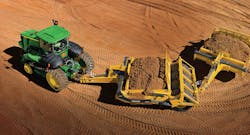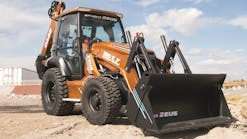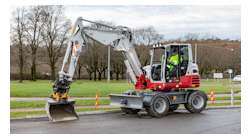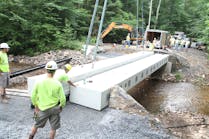Large wheel loaders and backhoes can be big beasts. They offer large carrying capacities, high lift capacities, and high production capabilities. You can find large wheel loaders in large quarries and mines and on heavy infrastructure projects performing tasks such as truck loading, material carrying, and stockpiling. Larger backhoes can be found on utilities, general construction, and smaller infrastructure projects performing tasks such as excavating, trenching, and truck loading.
“Right-sizing a machine to an application is very important, especially since wheel loaders are often used in production/cycle applications that impact upstream and downstream operations based on how efficiently they load materials,” says Andrew Dargatz, product marketing manager, Case Construction Equipment. “Too large of a machine will end up sitting idle for long periods of time, and too small of a machine won’t be able to keep up with production.”
Wheel loaders have grown in size and complexity since the Frank G. Hough Company invented them. The payloaders (as they were called then) sported bucket capacities of about 1/2 a cubic yard. By 1950, the most technologically advanced wheel loaders featured hydraulically-operated arms, a hydraulically-actuated bucket tilt, planetary axles, a torque converter, and a powershift transmission. All of these technologies have become common standard technology on wheel loaders even today.
In 1952, the Frank G. Hough Company was sold to the International Harvester Company, who continued to produce wheel loaders under the Hough name. In 1982, the International Harvester Company was acquired by Dresser Industries, who later merged with Komatsu in 1988.
What Big Can Do
Today, Komatsu’s largest (construction) wheel loader is the WA480-8. It features a maximum bucket capacity of 11 cubic yards, a 603 net horsepower (hp) engine, a dump clearance of more than 15 feet, a breakout force of 152,100 pounds, and an operating weight of 101,900 pounds. According to Craig McGinnis, product marketing manager, wheel loaders, Komatsu America, it is designed to complete site work, load asphalt plants, three-passing on highway (24- to 25-ton) trucks and supporting quarries.
“The WA480-8 is the perfect tool for quarry, infrastructure, and non-residential construction applications,” says McGinnis. “It’s the perfect three-pass loader for on-highway trucks and hoppers.”
Volvo’s largest wheel loader—the L350H—has an operating weight between 110,000 pounds to 124,000 pounds and a maximum bucket capacity of 8.1 to 16.6 cubic yards, a 528 net hp engine, a dump clearance of just more than 6 feet, a breakout force of more than 92,000 pounds (with a general purpose bucket), and an operating weight of nearly 120,000 pounds.
“Built and designed to be capable of working in extreme production environments, the L350H can handle a range of applications from mining and quarrying to heavy infrastructure,” says Eric Yeomans, product manager, wheel loaders, Volvo Construction Equipment. “The L350H can also be described as a production-class machine ideal for aggregates, open-pit mining, or large-scale earthmoving.”
“The 944K Hybrid wheel loader is the largest machine Deere manufactures,” says John Chesterman, product marketing manager, production class four-wheel drive loaders, John Deere Construction & Forestry. “This loader is a 9- to 10-cubic-yard machine weighing in around 120,000 pounds with 536 net horsepower. It was designed and built to satisfy the needs of aggregate producers. The loader may be placed in pit face feeding crushers or loading rigid frame haul trucks. Some high-production customers find this size loader better suited for on-road truck load-out applications as well. The Hybrid Drive system is most efficient when placed into a V-pattern loading operation; this tight operation enables the electric drive system to recover energy from the momentum of the machine and power the hydraulics.”
The Hitachi ZW550-6 features a bucket capacity of up to 9 cubic yards, a 509 net hp engine output, a dump clearance of 10 feet and 7 inches, an operating weight of 103,750 pounds, and a breakout force of 83,460 pounds.
“Hitachi’s ZW550-6 Wheel Loader is an ideal fit for mining and quarry applications. Designed and engineered to be exceptionally reliable and durable, these loaders deliver the highest levels of productivity in the most challenging work conditions. With standard Dual Z-Bar linkage, high tipping load, and high breakout force, this machine is well-balanced and powerful. The no DPF DEF Tier 4 technology is a real bonus in remote locations,” says Sam Shelton, marketing manager, Hitachi Construction Machinery Loaders America Inc.
The largest model in what Caterpillar calls mid-sized wheel loaders is the 982M. It features a bucket capacity range from 6.0–15.8 cubic yards, 398 net horsepower (ISO 9249), a dump clearance of more than 15 feet, a breakout force of 58,450 pounds, and an operating weight of 78,402 pounds. “The Caterpillar 982M was developed in response to quarries and yard load-out applications that wanted the ability to two-pass a typical 24–28 (short tons) on-highway truck,” says Lucas Sardenberg, product application specialist, Caterpillar.
Liebherr’s largest wheel loader is the L 586 XPower. It has a bucket capacity range of 7.2–11.1 cubic yards, a 354 net hp engine, a breakout force of 54,000 pounds, and an operating weight of approximately 73,000 pounds.
“Our largest wheel loader in the current G Series line is the 1121G,” says Dargatz. “Weighing in at 61,650 pounds, the 1121G features a 347 horsepower engine and is able to provide more than 56,000 pounds of breakout force. The 1121G is built for high-capacity production environments where truck loading, material carrying, and stockpiling is required.”
JCB’s largest wheel loader—the 457 ZX—features an operating weight of 45,300 pounds and a bucket capacity of 4.6 cubic yards. It’s powered by a 256 net hp engine and has a breakout force of more than 38,000 pounds. “The 457 is ideally suited to material processing and production applications at lumber yards, scrap handling yards, waste and recycling plants, and utilities. Other common applications include large construction projects and heavy snow clearing duties,” says Rupert Bradley, product manager, wheel loaders, JCB North America.
Backhoes tend to not be as large as wheel loaders but can still get quite large.
“The JCB 4CX-15 SUPER is sometimes called a ‘wheel loader backhoe’ due to its large size, four equal-size tires, and four-wheel steering with three steering modes,” says Diego Butzke, product manager, backhoe loaders, JCB North America. The 109-hp machine features a maximum dig depth in excess of 20 feet and a loader bucket lift capacity of 10,225 pounds at full height. “The JCB 4CX-15 SUPER features large front tires that provide excellent traction, which makes it particularly effective for pushing and breaking and ideally suited to applications that require high lift capacity and productivity at the loader end. Additionally, the JCB drive train provides higher ground clearance and enhanced flotation on soft ground, making the 4CX-15 SUPER an excellent choice on uneven ground or in environmentally sensitive locations.”
Case’s largest backhoe loader is the 110-hp 590 Super N. The front-end loader provides breakout forces of nearly 13,700 pounds. “The backhoe also delivers powerful breakout forces of more than 15,800 pounds, as well as a digging depth of 19.5 feet and a class-leading lifting capacity of 4,000 pounds. The 590 Super N is ideal for applications that require the versatility of a backhoe—general/non-residential construction, municipal work, utility, road building, and agriculture—with some extra horsepower on tap for high-volume, high-productivity job sites,” says Ed Brenton, product marketing manager, backhoe loaders, Case Construction Equipment.
Kubota’s largest backhoe—the M62—is designed to meet the needs of the construction, landscaping, and rental sectors. The M62 also offers contractors even greater excavating ability than its predecessors, with a 14-foot digging depth, a 17% improvement over the previous generation’s 12-foot max depth. The M62 has a bucket digging force of 6,572 pounds.
The M62 is powered by a turbocharged four-cylinder diesel engine that uses a Common-Rail direct injection system, which, along with Exhaust Gas Recirculation (EGR) and diesel particulate filters (DPF), enables compliance with Tier 4 Final emissions regulations. In addition, the engine is more powerful than its predecessors with a rated 59 net hp. It also boasts a large fuel tank—allowing for up to 48% more fuel capacity than previous Kubota backhoes.
The Komatsu WA480-8 has an operating weight
of 101,900 pounds.
Controlling the Beasts
Operating big machines is a big responsibility, but operating them doesn’t have to be difficult. Manufacturers have designed numerous features that help improve machine operation—helping operators get the most out of their machine. Some of the technologies going into these machines include multiple steering modes, joystick steering, touchscreen displays, operator guidance, automation, and telematics.
“While the JCB 4CX-15 SUPER has a relatively large footprint, the three steering modes enabled by the JCB four-wheel steering system make it extremely maneuverable,” says Butzke. “The 4CX-15 SUPER features front-wheel steering for traveling on the road, four-wheel steering with tight turning radius for confined work sites, and crab-steering for perfect machine positioning.”
“The 590 Super N has several features that make it easier on the operator,” says Brenton. “Options such as Ride Control and a selectable-speed Auto-Ride Control (four-wheel-drive only) improve operation, and our exclusive over-center backhoe design helps reduce material spillage during roading. Operators can also customize their forward/reverse transitions with the industry-exclusive SmartClutch modulation.”
“Caterpillar has made several improvements in the 982M in order to maximize operator efficiency,” says Sardenberg. “[Like] the introduction of standard joystick steering with K-Series, continuing in M-Series. For repetitive tasks such as truck loading, instead of having the operator turn the steering wheel multiple times a day, you have a simple left-hand joystick, which mimics the machine articulation. The system has an electric motor inside that provides operator feedback. The joystick is speed sensitive which means it will be harder to move the faster machine goes.”
In addition to joystick steering, Caterpillar has introduced, with M-Series mid-sized wheel loaders, a multi-color touchscreen in order to reduce the number of switches in the cab and simplify operation. Operators can check and activate features, not to mention customize the screen to their preference. The screen also serves as a payload data display and a backup monitor when the machine reverses.
“The L350H, along with all Volvo wheel loaders, is designed to make operating the machine easier from several different perspectives,” says Yeomans. “The new load-sensing hydraulic system is a great example. This improves the fuel efficiency, customizes the electric hydraulic controls, and tailors the controls to different operator skill levels. Operators can pick between three hydraulic modes—soft, normal, or active—to customize the machine’s level of responsiveness. The joystick controls, adjustable seat, and Volvo Co-Pilot Display also make the operator’s life easier and increase their productivity.”
“The 944K is a very easy machine for new and experienced operators to quickly become productive with,” says Chesterman. “Features like traction control, which automatically limits torque to any wheel when slippage occurs, enables the operator to concentrate on loading the bucket rather than monitoring tire spin. The hybrid electric drive system provides strong pushing power and quick acceleration, allowing it to load the bucket easily and climb ramps quickly. The hybrid drive system also allows the engine to be run in a finite speed range providing quick, responsive, and consistent hydraulic cycle times. When operated in the standard setting, engine speed is automatically controlled, allowing for it to operate in its most efficient speed range.”
The JCB 457 is equipped with the JCB CommandPlus Cab. “Inside the cab, commonly used controls—including forwards and reverse, transmission kick-down, proportional hydraulic aux controls, horn, and manual front axle differential lock—are located on the seat-mounted joystick. Other controls are grouped on the right-hand side A-pillar for easy reach,” says Bradley. “Prior to startup, JCB’s AutoCHECK system automatically checks fluid levels, and an available JCB Autogrease option greatly simplifies the pre-start routine. JCB Autogrease can be adjusted from within the cab to increase or decrease output as required. Once operational, JCB wheel loaders benefit from automatic transmissions and intelligent clutch cut-off [ICCO], together with the JCB Smoothride System [SRS], to allow the operator to focus on the task without the distraction of complex operating procedures.”
“The ZW550-6’s Dual Z-Bar linkage, 360-degree visibility, and rear-view camera along with convenient, organized dash allow the operator to access data at a glance and to stay focused on the task at hand. Fingertip control provided by the Joystick steering and hydraulic levers is effortless. Ride control kicks in automatically, providing a smooth, balanced ride. The ZW550-6 utilizes intuitive technology such as traction control, ride control, auto power-up, joystick steering with fingertip control, and an easy-to-read LCD color monitor to provide status updates at a glance,” says Shelton.
The operating and control instruments on Liebherr wheel loaders are well laid-out and user-friendly, claims the company. The Liebherr control lever, which is built into the operator’s seat as standard, allows all working and maneuvering operations to be performed with a high degree of precision and sensitivity. The loader’s new electro-hydraulic system allows the operator to program the lift arm and bucket positions from the cab. As well, the tipping speed for tilting back and dumping can be regulated individually. All operation-relevant data can be viewed quickly and efficiently via the height-adjustable touchscreen display.
“We’ve made multiple improvements to the operator environment on our new G Series wheel loaders,” says Dargatz. “The new cab features advanced electro-hydraulic controls, comfortable, ergonomic design, and updated operator interfaces. We’ve incorporated a solid-state controller that provides software control over electrical power distribution and basic vehicle functions. A membrane keypad has replaced a series of rocker switches for common machine functions, and a new steering console mimics the driver controls—lights, wipers, turn signals, etc.—found in most cars/trucks.”
Dargatz continues: “A new eight-inch LCD monitor provides the operator with simple control and greater insight over many of the loader functions and activities. This includes information on operating parameters such as fuel levels, temperatures and pressure readings, trip information, vital machine service information like upcoming maintenance reminders and machine diagnostics, an optional integrated rear-view camera, and fingertip selection of operating modes and features such as Auto Idle and Auto Shutdown.”
Komatsu’s wheel loaders come equipped with many features that improve performance. The machine’s Advanced Joystick Steering System (AJSS) eliminates the steering wheel for improved forward visibility and operator comfort while allowing the machine to operate at full speed. A seat-mounted electronic pilot controls levers with an FNR switch for operator ergonomics and convenience. Komatsu Auto Idle Shutdown reduces idle time after a pre-set amount of time, so the operator doesn’t have to do it. An integrated load meter system displays data directly to the machine’s main monitor and remotely via KOMTRAX. A new auto dig system controls bucket tilt and lifting by sensing pressure applied to the work equipment. The system can reduce operator fatigue and optimize bucket load.
The 457 ZX is JCB’s largest wheel loader.
These Beasts Are No Dinosaurs
Big loaders can be big beasts, but they aren’t dinosaurs. Larger machines tend to have more advanced technology than their smaller counterparts because the increase in capital cost is less significant when purchasing a $500,000 machine versus purchasing a $50,000 machine. A lot of the new technology going into these machines are telematics and automation. Big machines are getting smarter.
On Komatsu wheel loaders, SmartLoader Logic, combined with the lockup torque converter that activates in second, third, and fourth gear, provides optimal engine torque for improved acceleration, hill-climbing ability, a higher top speed, and fuel savings. The new auto dig system controls bucket tilt and lifting by sensing pressure applied to the work equipment. The system can reduce operator fatigue and optimize bucket load.
“Crucial to the popularity of JCB backhoe loaders is the company’s commitment to introduce new technology and exclusive features, making the current range of JCB backhoe loaders ‘smarter’ than many competing brands,” says Butzke. “Full-size JCB backhoes, including the 4CX-15 SUPER, for example, are equipped with a suite of up to seven automated features that enhance productivity and operator comfort. Those automated features include idling and revving the engine, raising the stabilizer legs, locking and unlocking the boom, and travel cruise control. Even under-the-hood daily checks are completed automatically within two seconds, and the cab is automatically warmed, and the glass defrosted, up to 30 minutes before work begins.”
“The Case G Series offers the following features: automatic bucket control features such as height control, return-to-dig and return-to-travel, Auto Idle, and Auto Shutdown,” says Dargatz. “Modern hydraulic systems have become more intelligent—as an example, Case has incorporated electro-hydraulic systems into their wheel loaders. With this advancement in technology comes improved functionality. Operators can activate and adjust automated machine functions, like height control, return-to-dig, and return-to-travel, as well as select different power modes or other machine functions from the comfort of the cab.”
Dargatz continues: “Case N Series backhoe loaders now feature an all-new Pilot Control hydraulic system for optimal precision and smoothness, offering the operator more control in critical applications. An Auto Engine Idle feature brings engine RPMs down to idle when the backhoe controls are not used for a set period of time. The engine will also shut down if the machine idles for a set period of time. Both Auto Engine Idle and Auto Engine Shutdown have adjustable settings to customize the timing to the operators’ style and preference. Another great feature now made standard is the Engine Protection Shutdown mode, which turns the engine off if engine temperature, drivetrain fluid temperature, or engine oil pressure go out of normal operating range.”
The ZW550-6 leads the pack in Tier 4 technology with a clean SCR system requiring NO DPF, and no DPF regen. The auto shutdown feature saves on fuel and cuts emissions. Global e-Service in conjunction with the Hitachi ConSite program provides 24/7 remote monitoring, daily operational reports analyzing key production and efficiency data, and maintenance data.
Telematics allows for remote monitoring of machine performance and health, remote diagnosis, and equipment maintenance planning. This data can lead to more efficiencies, greater productivity, and cost savings.
The latest version of Komatsu’s pioneering KOMTRAX telematics system and monitor provides key machine metrics, including KDPF (Komatsu diesel particulate filter) status and DEF-level data, fuel consumption, and performance information collected and sorted by operator ID.
“John Deere WorkSight is an exclusive suite of telematics that increases uptime while lowering operating costs. At its heart, JDLink Ultimate machine monitoring provides real-time utilization data and alerts to help maximize productivity and efficiency while minimizing downtime. Remote diagnostics enable your dealer to read codes, record performance data, and even update software without a trip to the job site.
ActiveCare Direct is another unique technology available with Volvo’s wheel loaders. ActiveCare Direct uses the telematics information about a fleet collected by CareTrack, Volvo’s telematics system, but sends the raw data to Volvo’s Uptime Center instead of directly to the customer or dealer. Data analysts sift through the thousands of alerts a fleet could receive and only send alerts to the customer or dealer when there is an actionable item. ActiveCare Direct also sends a monthly report along with recommendations from Volvo’s experts. It’s an alternative for customers who want the insight, preventative care, and increased uptime telematics provides without the time spent looking through non-critical case alerts that might not need an owner’s immediate attention.
LiDAT, Liebherr’s own data transmission and positioning system, provides machine data recording, data analysis, and fleet park management, as well as service via the web. “LiDAT offers comprehensive work deployment documentation, greater availability thanks to shorter downtimes, faster support from the manufacturer, quicker detection of strain/overload, and subsequently a longer service life of the machine as well as greater planning efficiency in your company,” claims the company.
During truck loading, operators have to achieve the target payload while avoiding over- or under-loading the truck. With the Caterpillar Production Measurement payload scale system, “Caterpillar helps operators avoid under- and over-loading. The system is intuitive, and the results can be tracked daily on Vision Link. Caterpillar Production Measurement also offers customers the ability to load different trucks and materials, so operators can easily access targets and payloads. The information is displayed in the color touchscreen monitor, which is positioned in the sightline of the bucket dump position to facilitate the workflow, not to mention avoiding adding another monitor to the cab and keeping it simple.”
Sardenberg continues: “Another technology available is object detection. Working in conjunction with the rearview camera, it provides an audible alarm once the machine is approaching an obstacle once reversing. The object detection is speed-sensitive, meaning if the machine is backing up faster, the alarm will start to sound earlier to allow for reaction time.” The detection system also ties to the color touchscreen monitor, which again eliminates the need for a secondary monitor mounted elsewhere in the cab.
From quarries to heavy infrastructure projects to massive earthmoving projects to large utility projects, these high-production machines are pretty versatile—just don’t expect to see them landscaping your backyard. They are also equipped with some of the most advanced technology, such as telematics, operator guidance systems, and advanced machine interfaces that make the machines easier to operate and smarter.










